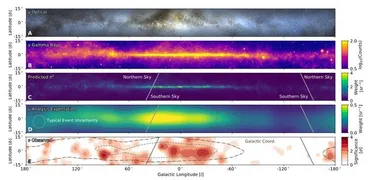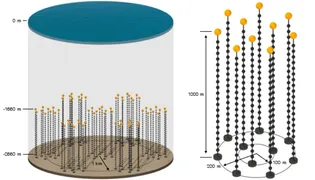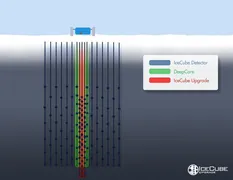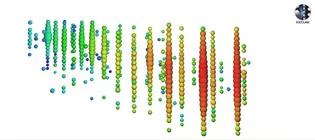News from Astroparticle Physics, IceCube and our Group
Hans Niederhausen receives 2023 Shakti Duggal Award
07/27/2023
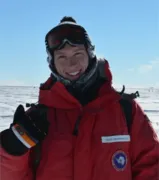
Hans Niederhausen, IceCube collaborator and postdoctoral research associate, who worked within our group between 2019 and 2022, has been selected as the recipient of the 2023 Shakti P. Duggal Award presented by the International Union of Pure and Applied Physics (IUPAP).
Niederhausen was acknowledged for “his development and application of advanced analysis methods in neutrino astronomy.” The Duggal Award recognizes “outstanding work by a young scientist in the field of Cosmic Ray Physics, including Astroparticle Physics.”
IceCube detects neutrinos from the Milky Way
06/29/2023
For the first time, the scientists of the international IceCube Collaboration have succeeded in detecting neutrinos from the Milky Way. The analysis of ten years of observation data using machine learning methods led to the success for which Elisa Resconi's group at the Technical University of Munich provided important preliminary work. In the next step, the researchers strive to understand from which celestial objects the observed high-energy neutrinos come.
The faint band of stars in the Milky Way, which glows at night in the night sky, has always impressed mankind, even if people have only started to understand the Milky Way as their home galaxy and to unravel its structure at the beginning of modern times. Now, the scientists of the IceCube Neutrino Observatory at the South Pole have succeeded for the first time in creating a neutrino image of the Milky Way.
Elisa Resconi elected first spokesperson of the P-ONE collaboration
02/16/2023
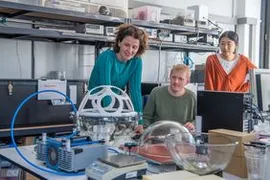
Elisa Resconi, who initiated the project for a new high-energy astrophysical neutrino detector in the Pacific Ocean, was elected the first spokesperson of the P-ONE collaboration. The Pacific Ocean Neutrino Telescope is a proposed cubic kilometer scale neutrino telescope to be deployed off the coast of Vancouver Island, Canada. The main goal of P-ONE is to advance the field of neutrino astronomy, extending the cosmic frontier at the highest energies to reveal previously unknown astronomical phenomena and their origin.
First neutrino image of an active galaxy
11/03/2022

For over ten years the IceCube Observatory in the Antarctic has been monitoring the light traces of extragalactic neutrinos. While evaluating the observatory's data, an international research team led by the Technical University of Munich (TUM) discovered a high-energy neutrino radiation source in the active galaxy NGC 1068, also known as Messier 77.
The universe is full of mysteries. One of these mysteries involves active galaxies with gigantic black holes located at their centers. "Today we still don't know exactly what processes take place there," says Elisa Resconi, Professor for Experimental Physics with Cosmic Particles at TUM. Now her team has made a major step towards solving this puzzle: The astrophysicists have discovered a high-energy neutrino source in the spiral galaxy NGC 1068.
ERC Advanced Grant for P-ONE project of Elisa Resconi
04/26/2022

Prof. Elisa Resconi recently launched an initiative to develop a new observatory for cosmic neutrinos in the Pacific Ocean, the Pacific Ocean Neutrino Experiment (P-ONE). For realizing the installation of the first telescope module with three strings, each 1000 meters long, off the coast of Canada at a depth of 2.6 kilometers, Elisa Resconi now received an ERC Advanced Grant.
IceCube: Celebrating the first 10 years of discovery
05/13/2021
IceCube began full operations on 13 May 2011 - ten years ago today - when the detector took its first set of data as a completed instrument. Since then, IceCube has been watching the cosmos and collecting data continuously for a decade.
The purpose of the unconventional telescope to detect signals from passing astrophysical neutrinos: tiny, extremely lightweight particles created by some of the most energetic and distant phenomena in the cosmos. IceCube’s founders believed that studying these astrophysical neutrinos would reveal hidden parts of the universe. Over the course of the next decade, they would be proven right.
IceCube detection of a high-energy particle proves 60-year-old theory
03/10/2021
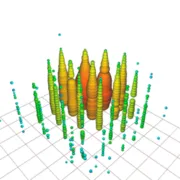
For the first time, a resonance at ultra-high energies, predicted by the eventual Nobel laureate Sheldon Lee Glashow in 1960, was observed. The scientists of the IceCube collaboration identified a particle shower detected in the IceCube Neutrino Observatory as resulting from an interaction of a cosmic electron anti-neutrino with an atomic electron as a long-sought Glashow resonance. The result was published in Nature.
On December 6, 2016, a high-energy electron antineutrino hurtled to Earth from outer space at close to the speed of light carrying 6.3 petaelectronvolts (PeV) of energy. Deep inside the ice sheet at the South Pole, it smashed into an electron and produced a particle that quickly decayed into a shower of secondary particles. The interaction was captured by the IceCube Neutrino Observatory buried into the Antarctic Ice of the South Pole.
P-ONE: Initiative for a new, large-scale Neutrino Observatory in the Pacific Ocean
09/09/2020
The “IceCube” neutrino observatory deep in the ice of the South Pole has already brought spectacular new insights into cosmic incidents of extremely high energies. In order to investigate the cosmic origins of elementary particles with even higher energies, Prof. Elisa Resconi from the Technical University of Munich (TUM) has now started an international initiative to build a neutrino telescope several cubic kilometers in size in the northeastern Pacific.
First upgrade of the IceCube Neutrino Observatory
07/16/2019
The IceCube Neutrino Observatory, the Antarctic neutrino detector that identified the first likely source of high-energy neutrinos and cosmic rays, is getting an upgrade. Seven strings of optical modules will be inserted at the bottom center of the 86 existing strings, adding more than 700 new, enhanced optical modules to the 5,160 sensors already embedded in the ice beneath the geographic South Pole, among them 21 calibration modules developed and tested in the group of Prof. Elisa Resconi at Technical University of Munich.
Blazar accelerates cosmic neutrinos to highest energies
07/12/2018
For the first time ever, scientists have determined the cosmic origin of highest-energy neutrinos. A research group led by IceCube scientist Elisa Resconi, spokesperson of the Collaborative Research Center SFB1258 at the Technical University of Munich (TUM), provides an important piece of evidence that the particles detected by the IceCube neutrino telescope at the South Pole originate from a galaxy four billion light-years
To rule out other origins with certainty, the team led by neutrino physicist Elisa Resconi from the Technical University of Munich and multi-wavelength astronomer and blazar expert Paolo Padovani from the European Southern Observatory (ESO) examined a 1.33-degree sky region around the position that a high-energy neutrino that hit the IceCube detector on September 22, 2017 emanated from.
An international cooperation involving Resconi had associated the neutrino to a known blazar with the catalogue number TXS 0506+056 an active galaxy whose jet of high-energy particles points directly towards Earth. “It is one of the brightest and most peculiar objects ever observed,” says Elisa Resconi.
Elisa Resconi appointed new Max Planck Fellow
08/08/2017
Elisa Resconi was named Max Planck Fellow at the Max Planck Institute for Physics (MPP). She will build a new research group dedicated to the theoretical and experimental aspects of neutrino physics. Elisa Resconi is Professor for Experimental Physics with Cosmic Particles at the TUM and spokesperson of the CRC1258 Neutrinos and Dark Matter in Astro- and Particle Physics.
